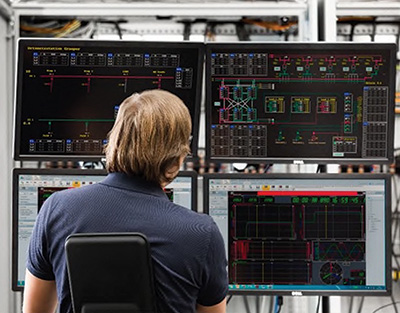Modular SCADA platform aims to ensure stability in power grids
03/06/2025
The European electricity supply system is currently in flux as a result of the energy transition. An increasing number of plants and systems are feeding into the decentralised power grid through power electronics. In the future, hybrid power grids will incorporate sections with alternating current (AC) and direct current (DC) lines. The partners in the InterSCADA EU project are developing a modular supervisory control and data acquisition (SCADA) platform intended to help grid operators throughout Europe to maintain system stability in increasingly hybrid AC/DC power grids. In this interview, Robin Patrick Williams, a research scientist at the Fraunhofer Institute for Applied Information Technology FIT, explains why a SCADA platform is necessary in order to automate future transmission and distribution grids. Williams and Professor Antonello Monti, a group manager at Fraunhofer FIT, are jointly responsible for coordinating the project. | ||
| The InterSCADA platform will allow distribution and transmission grid operators to respond quickly to sudden system disruptions Image courtesy of Martin Braun |
What goals are you pursuing in the InterSCADA project?
In the EU-funded InterSCADA project, we are developing and testing a vendor-independent open-source control system platform in collaboration with 17 partners. Newly implemented monitoring and control functions, along with automation mechanisms, allow distribution and transmission grid operators to respond quickly to sudden system disruptions.
What is a SCADA platform?
SCADA software has existed for decades. The acronym stands for ‘supervisory control and data acquisition’, encompassing control systems used to monitor and control plants, systems and infrastructure. A few years back, we saw the emergence of projects that take modular open-source approaches. In InterSCADA, specific modules or ‘services’ are being developed and tested for a platform like this.
What role does InterSCADA play in this?
The specific role of InterSCADA lies in developing algorithms and software modules for grid operation in the increasingly interlinked hybrid alternating current (AC)/direct current (DC) networks. At the same time, the demonstrators serve as proof of concept for the new modular approach.
Which features set InterSCADA apart?
InterSCADA covers a wide range of tasks. For example, the platform collects information on grid status and determines line capacity utilisation. We develop suitable algorithms for this at Fraunhofer FIT. The platform also handles active fault localisation and troubleshooting at various voltage levels. This is becoming increasingly necessary in the low-voltage segment. It also provides the translation tool for the communication protocols and machine languages of the various devices involved (switches, phasor measurement units (PMUs) and protection devices).
Why is it important to be able to respond flexibly to dynamic grid situations?
The European energy sector aims to reduce CO₂ emissions and dependency on energy imports by generating increasing amounts of power from renewable energy sources such as wind and solar, which are often connected to the grid via power electronics. In addition to connection to power grids via electronic inverters, DC lines and grids are expanded in some cases (such as with offshore wind farms) and linked to the AC grid.
Beyond that, more and more companies are shifting the supply of power to their factories and industrial production plants from AC to DC. All this is resulting in hybrid networks and maintaining their stability underscores the need for advanced grid control concepts.
Can the platform be used Europe-wide?
There is already a lively discussion across the whole of Europe between the different grid areas. The grid operators have to abide by the regulations and standards that apply across the entire EU. These standards will be expanded to include new generators and the control systems for hybrid grids are expected to be in demand across Europe.
What tests are planned?
The InterSCADA platform will be used and tested in demonstrators in four European countries: France, Greece, Italy and Spain. The goal is to ensure that the desired solutions can be replicated in diverse geographic settings and under different regulatory and technical conditions.